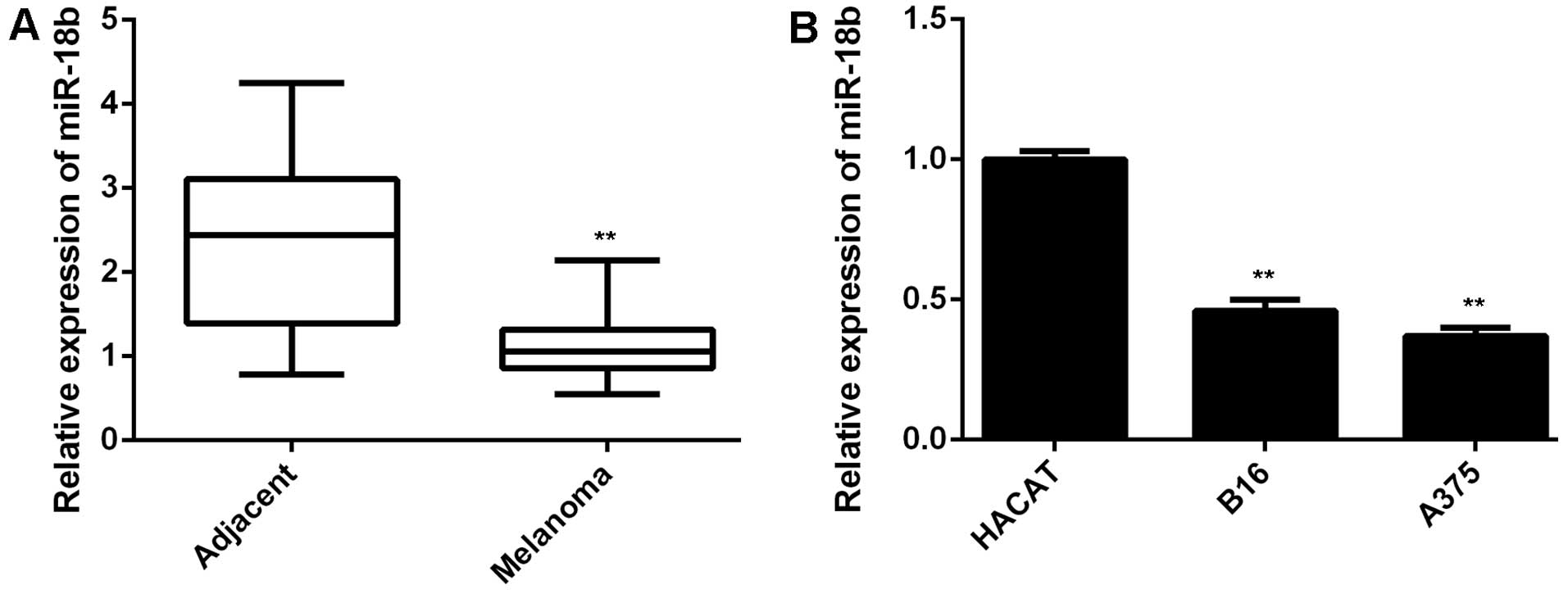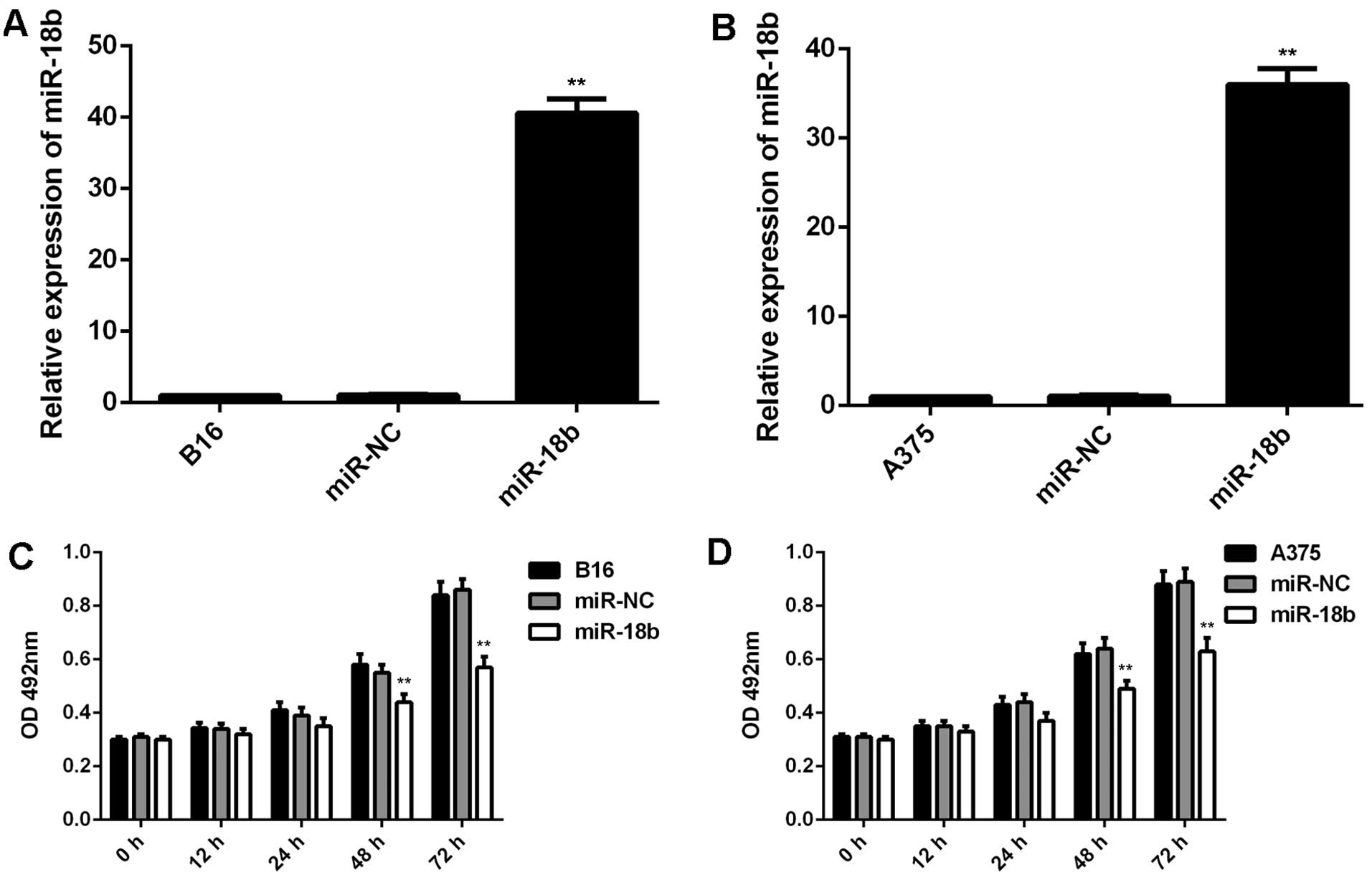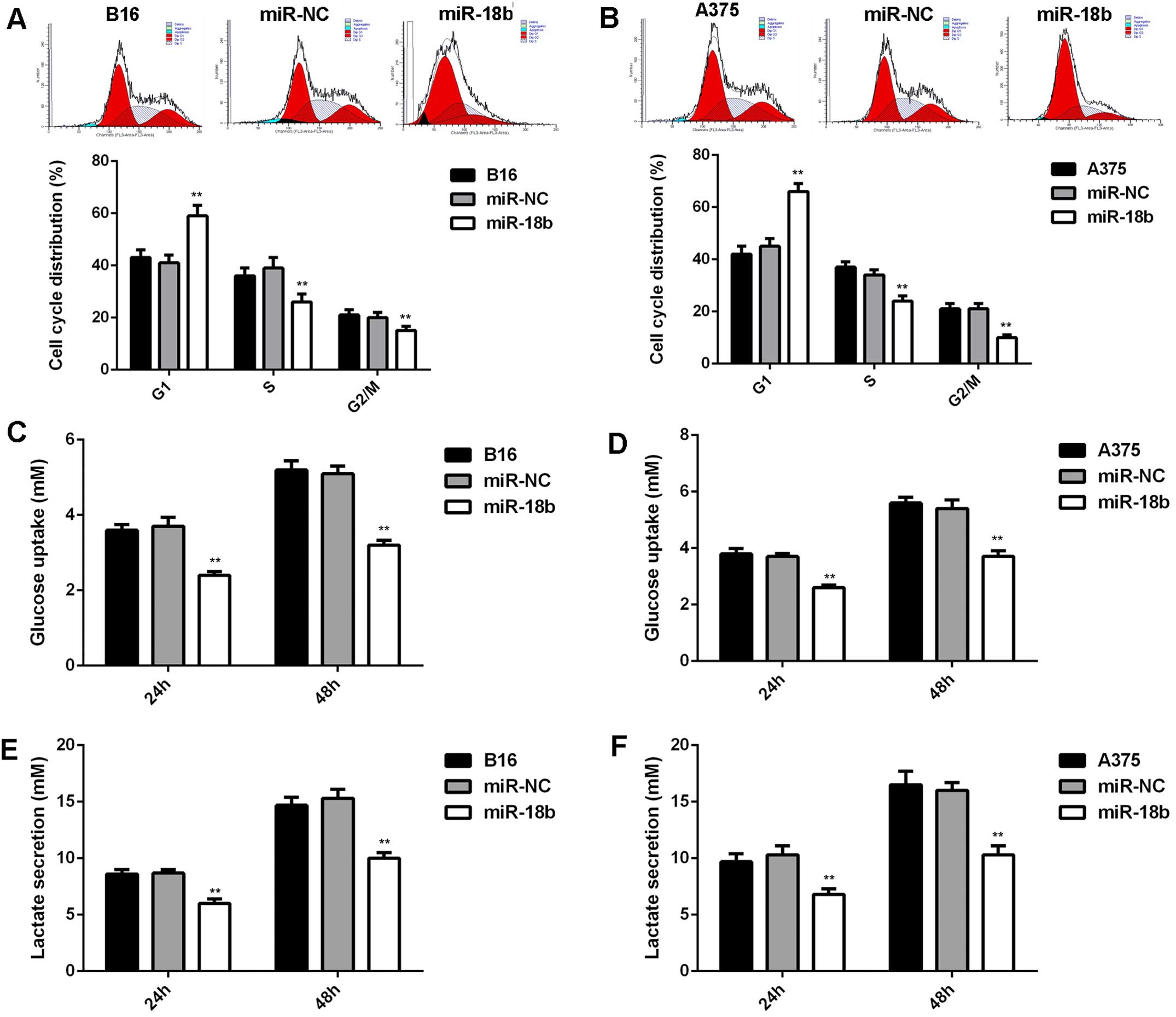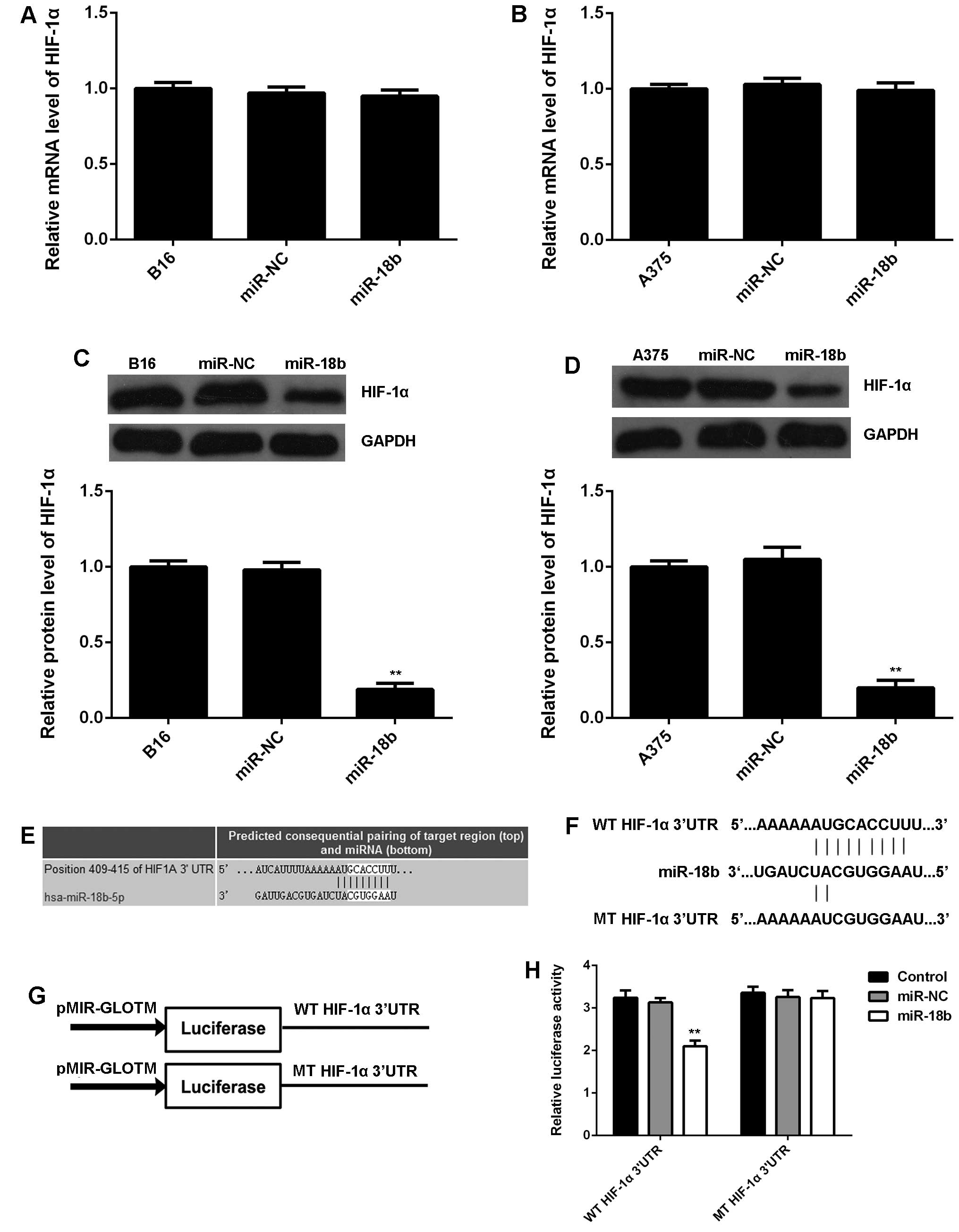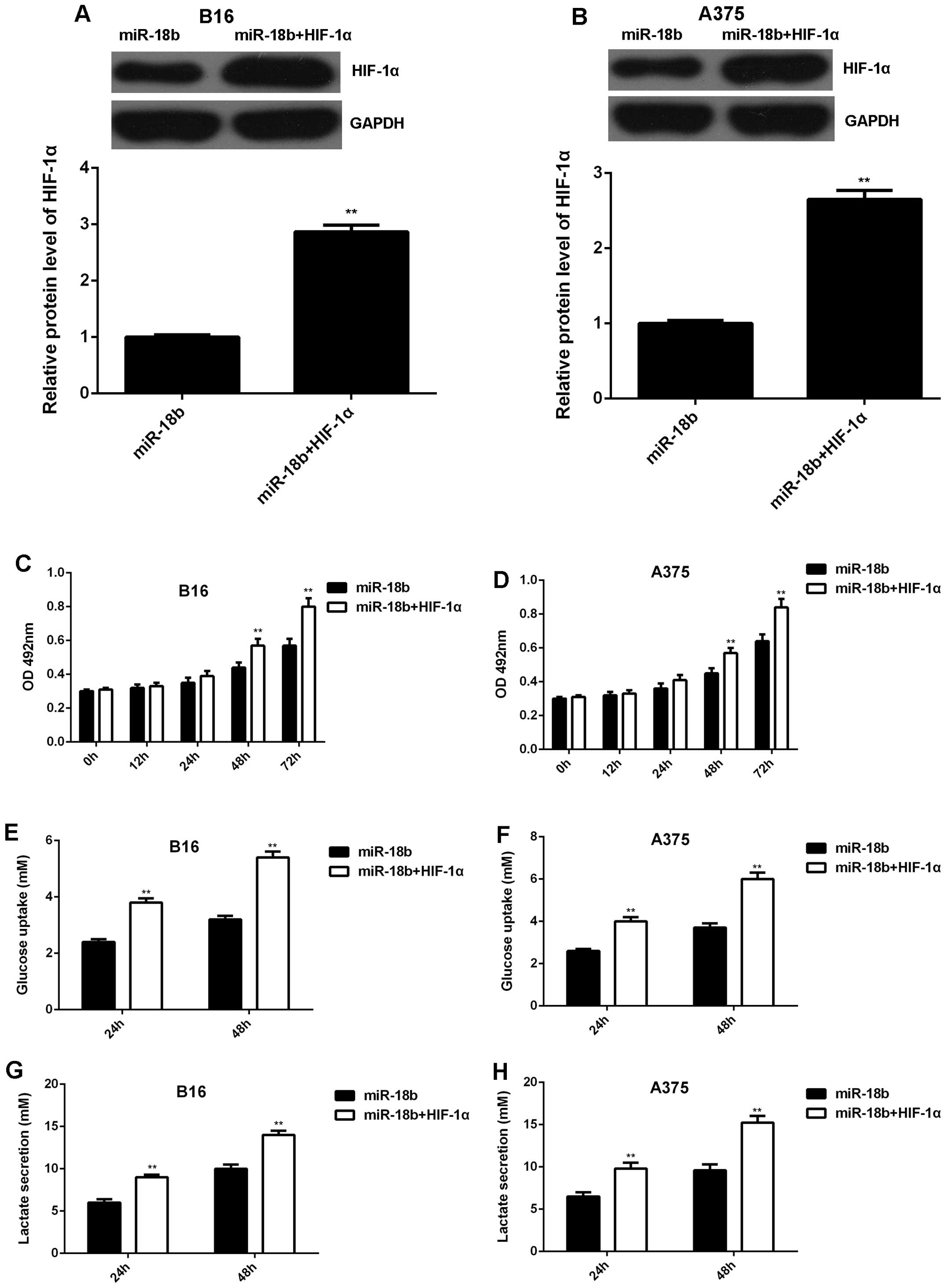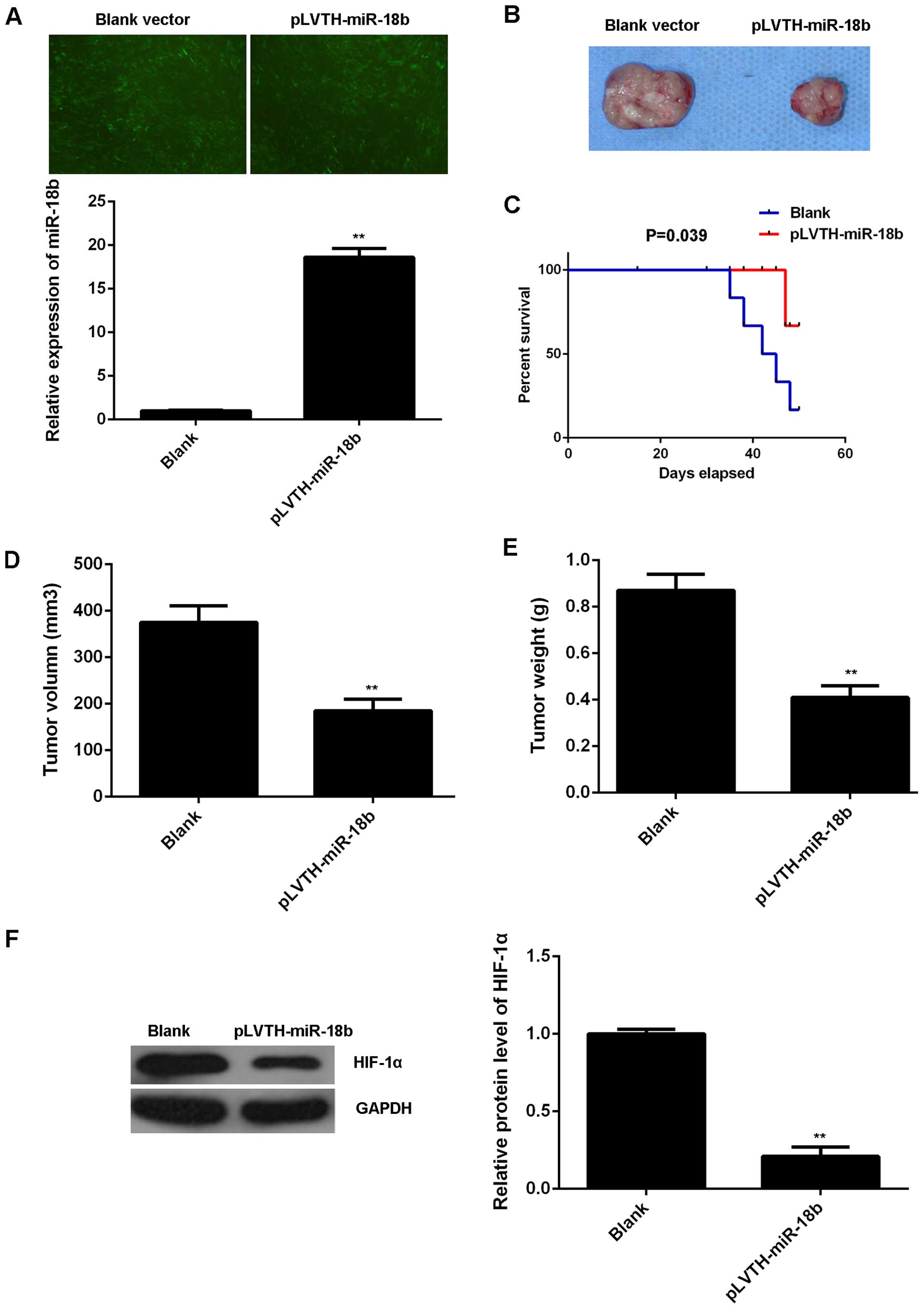MicroRNA-18b inhibits the growth of malignant melanoma via inhibition of HIF-1α-mediated glycolysis
Retraction in: /10.3892/or.2021.8161
- Authors:
- Published online on: May 20, 2016 https://doi.org/10.3892/or.2016.4824
- Pages: 471-479
Abstract
Introduction
Malignant melanoma (MM), a malignant tumor of melanocytes, is characterized by a rapid progression and metastasis (1). It ranks as the fifth most common cancer for male and the seventh most common malignancy in female (2,3). In recent years, a large number of studies have focused on the pathogenesis of MM, and deregulation of oncogenes and tumor suppressors have been reported to play key roles in the development and progression of MM (4,5). However, the detailed molecular mechanism underlying MM still remains largely unclear.
Cancer cells preferentially utilize glycolytic metabolism to produce ATP, even in the presence of oxygen, a phenomenon termed aerobic glycolysis (6,7). Inhibition of glycolysis has been suggested to improve the outcomes for cancer therapy (8,9). Hypoxia-inducible factor (HIF)-1, a heterodimer composed of an α and a β subunit, plays a critical role in cellular and systemic homeostatic response to hypoxia by activating transcription of many genes involved in energy metabolism, and other genes whose protein products increase oxygen delivery or facilitate metabolic adaptation to hypoxia (10,11). Our previous study reported that HIF-1α played an oncogenic role in MM (12). However, the regulatory mechanism of HIF-1α in MM remains largely unknown.
MicroRNAs (miRs) are a class of small non-coding RNAs. They can inhibit the gene expression via directly binding to the 3′ untranslational region (UTR) of their target mRNA, leading to translational repression (13,14). Moreover, miRs have been demonstrated to mediate various biological processes, such as cell proliferation, cell cycle progression, glycolysis, as well as tumorigenesis (15,16). miR-18b plays an oncogenic or tumor suppressive role in different cancer types (17). For instance, miR-18b is upregulated in HCC, and higher miR-18b level predicates poor prognosis (18). Moreover, overexpression of miR-18b increased HCC cell proliferation, while inhibited cell adhesion ability, indicating that miR-18b acts as an oncogene in HCC (18). On the contrary, miR-18b was recently reported to inhibit MM (19). It was downregulated in MM by virtue of hypermethylation, and overexpression of miR-18b decreased MM cell viability, induced cell apoptosis, and inhibited tumor growth in vivo (19). However, the exact role of miR-18b in the regulation of energy metabolism in MM has not been reported.
Therefore, the present study aimed to investigate the expression of miR-18b in MM tissues and its association with clinicopathological features. Moreover, we also studied the exact role and underlying mechanism of miR-18b in regulating MM growth and energy metabolism.
Materials and methods
Ethics statement
The present study was approved by the Ethics Committee of Central South University, Changsha, China.
Tissue samples
A total of 68 pairs of MM tissues and adjacent normal tissues were collected. The clinicopathological information is summarized in Table I. These MM patients received neither radiation therapy nor chemotherapy before surgical resection. Written informed consents had been obtained. Tissues were snap-frozen in liquid nitrogen, then stored at −80°C before use.
Table IRelationship between miR-18b expression and clinicopathological features of malignant melanoma patients. |
Cell culture
Human embryonic kidney HEK293 cells, MM B16 and A375 cell lines, and normal skin HACAT cells were obtained from the American Type Culture Collection (ATCC; Manassas, VA, USA). Cells were cultured in RPMI-1640 medium (Life Technologies, Carlsbad, CA, USA) added with 10% fetal bovine serum (FBS; Life Technologies) in a 37°C humidified atmosphere of 5% CO2.
Real-time RT-PCR assay
Total RNA was extracted using TRIzol reagent (Life Technologies) according to the manufacturer's instruction. For miR detection analysis, real-time PCR was performed using PrimeScript® miRNA RT-PCR Kit (Takara, Dalian, China), according to the manufacturer's instructions. U6 was used as the internal reference. For qPCR detection, 1 μl cDNA solution, 10 μl PCR Master Mix, 2 μl of primers, and 7 μl H2O were mixed to obtain a final reaction volume of 20 μl. The reaction conditions were 95°C for 10 min, and 40 cycles of 95°C for 15 sec and 60°C for 30 sec. The relative expression was analyzed by the 2−ΔΔCt method (20).
Western blot analysis
Cells were solubilized in cold RIPA lysis buffer (Beyotime Institute of Biotechnology, Shanghai, China). The proteins were separated using 10% sodium dodecyl sulfate polyacrylamide gel electrophoresis and transferred onto a polyvinylidene difluoride (PVDF) membrane (Life Technologies). The PVDF was incubated with phosphate-buffered saline containing 5% milk overnight at 4°C. Then, the PVDF membrane was incubated with rabbit polyclonal anti-human HIF-1α antibody (1:100, ab2185; Abcam, Cambridge, MA, USA) and rabbit monoclonal anti-human GAPDH antibody (1:200, ab181602; Abcam) at room temperature for 3 h. After washed by PBS for 3 times, the membrane was incubated with goat anti-rabbit secondary antibody (1:10,000, ab7090; Abcam) at room temperature for 1 h. After three washes by PBS, an ECL kit (Pierce Biotechnology, Rockford, IL, USA) was used to perform chemiluminescence detection. The relative protein expression was analyzed by Image-Pro® Plus software version 6.0 (Media Cybernetics, Inc., Rockville, MD, USA), represented as the density ratio vs. GAPDH.
MiR mimic, inhibitor and plasmid
Scramble miR mimic (miR-NC), miR-18b mimic, blank pcDNA3.1 vector, pcDNA3.1-HIF-1α plasmid, and blank pLVTH vector, pLVTH-miR-18b lentiviral plasmid were purchased from Amspring Co., (Changsha, China).
Cell transfection
Cells (1×105 cells/well) were seeded in 24-well plates, and cell transfection was performed using 100 nM of diluted Lipofectamine 2000 (Life Technologies), according to the manufacturer's instruction. Cells were then cultured in a cell incubator containing 5% CO2 at 37°C, and harvested at 48 h post-transfection for further analysis.
Cell proliferation analysis
Cells (5,000 cells/well) were cultured in a 96-well plate, each well had 100 μl fresh serum-free medium with 0.5 g/l MTT. Following incubation at 37°C for 0, 24, 48 and 72 h, the medium was removed by aspiration and 50 μl dimethyl sulfoxide was added to each well. Following incubation at 37°C for 10 min, the A570 of each sample was measured using a plate reader.
Cell cycle distribution analysis
Cells (2×105) were washed twice with DPBS and resuspended in 70% ethanol. After fixed overnight at −20°C, cells were pelleted, washed twice in PBS with 3% BSA and pelleted. Cells were then resuspended and incubated for 30 min at room temperature in propidium iodide staining buffer containing 3% BSA, 40 μg/ml propidium iodide, and 0.2 mg/ml RNase in PBS. DNA content analyses were carried out using the flow cytometry (FACSCalibur; Beckman Coulter).
Glucose uptake analysis
After cultured for 24 or 48 h, the medium supernatant was collected and diluted 1:4,000 in DPBS. The amount of glucose in the supernatant was then detected using the Glucose Uptake Colorimetric assay kit (Sigma-Aldrich) in accordance with the manufacturer's protocol. The absorbance was detected at 412 nm with ELx800 type ELISA reader (BioTek Instruments, Inc., Winooski, VT, USA).
Lactate secretion analysis
Metabolites were quantified from medium supernatant using a Lactate Assay kit (Sigma-Aldrich) after cultured for 24 or 48 h. Assays were performed according to the manufacturer's instructions. The concentrations were normalized to protein contents determined by a BCA protein assay (Pierce Biotechnology) using bovine serum albumin (Sigma-Aldrich) as a standard protein.
Bioinformatics analysis
Targetscan software (www.targetscan.org/) was used to analyze the putative target genes of miR-18b.
Luciferase reporter assay
Mutations of miR-18b binding sites in the HIF-1α 3′-untranslated region (UTR) were introduced using Easy Mutagenesis System kit (Promega, Madison, WI, USA), according to the manufacturer's instruction. The wild-type (WT) or mutant type (MT) of HIF-1α 3′UTR was cloned downstream of the firefly luciferase coding region of pmirGLO™ Luciferase vector (Promega), generating the WT or MT HIF-1α 3′UTR reporter plasmid, respectively. HEK293 cells were co-transfected with WT-HIF-1α-3′UTR or MUT-HIF-1α-3′UTR reporter plasmid, and miR-18b mimic or miR-NC, respectively. After cultured at 37°C for 48 h, cells were lysed using the lysis buffer (Promega), and Dual-luciferase reporter assay system (Promega) was used to detect the luciferase activity, according to the manufacturer's instruction.
Tumor growth in vivo
In the control group, B16 cells were stably transfected with the blank pLVTH vector. In the experiment group, B16 cells were stably transfected with the pLVTH-miR-18b lentiviral plasmid. Male BALB/C-nu/nu nude mice (n=6) were injected subcutaneously in the dorsal flank with 1×107 cells of each group. The mice still alive were sacrificed on day 50 after tumor implantation. Tumor volume was calculated by using the formula V (mm3) = 0.5 × a × b2 (a maximum length to diameter, b maximum transverse diameter). Tumor weight was also recorded.
Statistical analysis
Data are expressed as mean ± SD. GraphPad Prism 5 software (Graphpad Software, Inc., La Jolla, CA, USA) was used for statistical analysis. Data were analyzed by using a Student's t-test for two-group comparison and one-way ANOVA for multiple-group comparison. The contingency data were analyzed by using the Chi-squared test. P-value <0.05 was considered statistically significant.
Results
miR-18b is downregulated in MM
In the present study, we first performed qPCR to examine the miR-18b level in a total of 68 pairs of MM tissues and their matched adjacent non-tumor tissues. As demonstrated in Fig. 1A, the expression of miR-18b was significantly lower in MM tissues, when compared with that in adjacent non-tumor tissues. These MM patients were then divided into two groups, low miR-18b expression group and low miR-18b expression group, according to the mean value of the miR-18b expression as the cut-off point. The association between the miR-18b expression and the clinicopathological features of MM were then analyzed. We found no significant association between the miR-18b expression and the age, gender, or lymph node metastasis (Table I). However, low miR-18b level was significantly associated with the increased tumor thickness as well as advanced tumor stage (Table I), suggesting that the downregulation of miR-18b may play a role in MM progression. In addition, we then examined the miR-18b level in MM B16 and A375 cell lines. Human normal skin HACAT cells were used as control. As shown in Fig. 1B, the expression of miR-18b was also markedly reduced in B16 and A375 cells compared to HACAT cells. Therefore, miR-18b was significantly downregulated in MM.
miR-18b overexpression decreases cell proliferation, induces cell cycle arrest and inhibits glycolysis in MM cells
We further used B16 and A375 cells to study the role of miR-18b in MM. B16 and A375 cells were transfected with miR-NC or miR-18b mimic, respectively. Real-time qPCR data showed that the miR-18b level was significantly increased after transfection with miR-18b mimic, but not with miR-NC, compared to the control group (Fig. 2A and B). We further performed MTT assay to examine cell proliferation, and found that overexpression of miR-18b significantly decreased the proliferation of B16 and A375 cells compared the control group (Fig. 2C and D).
As cell cycle progression is crucial for cell proliferation (21), we further examined the cell cycle distribution in each group. As indicated in Fig. 3A and B, ectopic expression of miR-18b induced a significant cell arrest at G1 stage, contributing to the suppressive effect of miR-18b on MM cell proliferation. In addition, energy metabolism is also important for cancer cell proliferation. Thus, we further examined the glycolysis level of MM cells with or without miR-18b upregulation. As shown in Fig. 3C–F, the glucose uptake and lactate secretion were significantly decreased in MM cells transfected with miR-18b mimic, indicating that the glycolysis was suppressed after miR-18b overexpression.
HIF-1α is a direct target gene of miR-18b in MM cells
As HIF-1α is a key regulator in glycolysis (22), we further examined the mRNA and protein expression of HIF-1α in MM cells with or without miR-18b overexpression. No significant difference was observed in the mRNA level of HIF-1α in each group (Fig. 4A and B). However, miR-18b upregulation caused a remarkable reduction in the protein level of HIF-1α in B16 and A375 cells, when compared to the control group (Fig. 4C and D), suggesting that miR-18b negatively regulates the HIF-1α expression at a post-transcriptional level. Therefore, HIF-1α may be involved in the miR-18b-mediated MM cell glycolysis. To further reveal the relationship between miR-18b and HIF-1α, bioinformatics analysis was performed, and TargetScan software data showed a perfect base pairing between the 3′UTR of HIF-1α mRNA and the seed sequence of miR-18b (Fig. 4E), suggesting that HIF-1α is a target gene of miR-18b. To further confirm the targeting relationship between miR-18b and HIF-1α, the WT or MT of HIF-1α 3′UTR (Fig. 4F) was cloned into luciferase reporter vector, generating the WT or MT HIF-1α 3′UTR reporter plasmid, respectively (Fig. 4G). Luciferase reporter assay data showed that co-transfection with WT HIF-1α 3′UTR reporter plasmid and miR-18b mimic caused a significant decrease in the luciferase activity, which was rescued by transfection with MT-HIF-1α 3′UTR reporter plasmid (Fig. 4H). Accordingly, HIF-1α is a direct target gene of miR-18b, and the protein expression of HIF-1α is negatively regulated by miR-18b in MM cells.
Overexpression of HIF-1α rescues the inhibitory effect of miR-18b on MM cell proliferation and glycolysis
We further studied whether HIF-1α was involved in the miR-18b-mediated MM cell proliferation and glycolysis. PcDNA3.1-HIF-1α plasmid was transfected into the miR-18b-overexpressing B16 and A375 cells. After transfection, the protein level of HIF-1α was significantly increased (Fig. 5A and B). MTT assay was then conducted to examine the cell proliferation. Our data showed that the proliferation was higher in B16 and A375 cells co-transfected with miR-18b mimic and HIF-1α plasmid, when compared to miR-18b-overexpressing B16 and A375 cells (Fig. 5C and D). The glycolysis level was then analyzed. As indicated in Fig. 5E–H, the glucose uptake and lactate secretion were also higher in MM cells co-transfected with miR-18b mimic and HIF-1α plasmid, when compared to cells transfected with only miR-18b mimic. Therefore, our data demonstrate that overexpression of HIF-1α rescued the inhibitory effect of miR-18b on MM cell proliferation and glycolysis.
miR-18b upregulation reduces MM growth and glycolysis in vivo
To further reveal the role of miR-18b in MM in vivo, pLVTH-miR-18b lentiviral plasmid was stably transfected into B16 cells. After transfection, the miR-18b level was significantly increased compared to the control B16 cells transfected with blank pLVTH vector (Fig. 6A). Then, nude mice were subcutaneously implanted with these cells. The mice were sacrificed on day 50 after implantation and the xenografts were obtained (Fig. 6B). The survival curve data indicated that overexpression of miR-18b decreased the death rate caused by tumor growth (Fig. 6C). The tumor volume and weight were then determined. As indicated in Fig. 6D and E, the tumor volume and weight were significantly decreased in the miR-18b overexpression group compared to the control group. We also examined the protein expression of HIF-1α in the tumor xenografts. Our data showed that the protein level of HIF-1α was also lower in the miR-18b overexpression group (Fig. 6F). Therefore, our findings suggest that miR-18b has a suppressive effect on the MM growth in vivo, probably through inhibition of HIF-1α-mediated glycolysis.
Discussion
miR-18b has recently been demonstrated to play a suppressive role in MM (19). However, the underlying mechanism remains largely unknown. In the present study, we found that miR-18b was significantly downregulated in MM tissues and cell lines. Moreover, low miR-18b expression was significantly associated with the tumor thickness and stage. Overexpression of miR-18b decreased cell proliferation, induced cell cycle arrest, and inhibited glycolysis in A375 and B16 cells. HIF-1α, a key regulator in glycolysis, was further identified as a target gene of miR-18b in MM cells, and overexpression of HIF-1α rescued the suppressive effect of miR-18b on MM cell proliferation and glycolysis. Moreover, in vivo study showed that overexpression of miR-18b inhibited the MM growth as well as the tumor-related death, accompanied with HIF-1α downregulation. These data demonstrate that miR-18b inhibits the growth and glycolysis of MM cells in vitro and in vivo through directly targeting HIF-1α.
In recent years, many miRs have been implicated in the development and progression of MM (23,24). For instance, miR-203 was significantly downregulated in MM, and upregulation of miR-203 suppressed A375 cell migration via inhibition of versican (25). Overexpression of miR-193b repressed MM cell proliferation (26). In the present study, we found that miR-18b was also downregulated in MM tissues and cell lines. Moreover, low expression of miR-18b was significantly associated with the increased tumor thickness and advanced tumor stage. These data suggest that miR-18b was involved in the malignant progression of MM. The sample size of tumor tissues was not very large, and expanding it will further help confirm the relationship between the miR-18b expression and clinicopathological features of MM patients. In addition, the association between the miR-18b expression and the survival time of patients with MM should also be investigated in future. To further reveal the role of miR-18b in MM, B16 and A375 cells were transfected with miR-18b mimic to upregulate its expression level. Overexpression of miR-18b significantly decreased the proliferation of B16 and A375 cells, suggesting that miR-18b may have inhibitory effect on MM growth. Another study reported that overexpression of miR-18b caused suppression of MM cell colony formation (19). Furthermore, we examined the cell cycle distribution in B16 and A375 cells with or without miR-18b overexpression, and found that overexpression of miR-18b induced a remarkable cell cycle arrest at G1 stage. Our data suggest that the miR-18b-induced cell cycle arrest contributes to the decreased cell proliferation.
Increased glycolysis in tumor cells compared to normal tissues is observed in most cancers, which is in accordance with the Warburg effect that the aerobic glycolysis is a major source of energy in cancer cells (27). As no previous study has focused on the effect of miR-18b on the energy metabolism in MM, we then examined the glycolysis level in B16 and A375 cells with or without overexpression of miR-18b. Interestingly, our data showed that overexpression of miR-18b led to a significant decrease in the glucose uptake and lactate secretion, indicating that miR-18b upregulation suppressed the glycolysis in MM cells. In fact, several other miRs were also found to be involved in the regulation of glycolysis in human cancers. For instance, overexpression of miR-144 enhanced glucose uptake and lactate production in ovarian cancer cells, leading to a rapid growth of ovarian cancer cells (28). Xu et al (29) reported that inhibition of miR-340 increased Glut1 expression, leading to an increase in lactate secretion and glucose uptake rate. Moreover, let-7a was found to decrease key anabolic enzymes and increase both oxidative phosphorylation and glycolysis in metastatic MM cells (30). However, evidence is rare in the role of miRs in regulating glycolysis in MM. Thus, the present study expands the understanding of the function of miRs in MM glycolysis.
Then we focused on the molecular mechanism underlying miR-18b inhibited glycolysis in MM. HIF-1α has been demonstrated to play a key role in the development and progression of different cancer types through regulating the cellular and systemic homeostatic responses to hypoxia (31). Moreover, HIF-1α was found to be significantly upregulated in MM, and the increased HIF-1α expression predicated poor prognosis in MM (32,33). In the present study, HIF-1α was found to be significantly downregulated in miR-18b-overexpressing MM cells, and was then identified as a direct target of miR-18b. Further investigation showed that overexpression of HIF-1α rescued the suppressive effect of miR-18b on the proliferation and glycolysis in MM cells. Thus, HIF-1α indeed acts as a downstream effector in the miR-18b-mediated MM cell growth. Finally, we showed that overexpression of miR-18b inhibited MM growth in vivo, accompanied with HIF-1α downregulation, further suggesting that miR-18b may become a promising candidate for the treatment of MM.
To the best of our knowledge, the present study for the first time demonstrates that miR-18b can inhibit the growth and glycolysis of MM cells, partly at least, via direct inhibition of the HIF-1α expression. Therefore, we suggest that the miR-18b/HIF-1α may serve as a potential therapeutic target for MM.
Acknowledgments
This study was supported by the Medical and Health Project of Science and Technology Development Fund of Longgang District, Shenzhen City (YLMS20150515113353372).
References
|
Rastrelli M, Tropea S, Rossi CR and Alaibac M: Melanoma: Epidemiology, risk factors, pathogenesis, diagnosis and classification. In Vivo. 28:1005–1011. 2014.PubMed/NCBI | |
|
Trotter SC, Sroa N, Winkelmann RR, Olencki T and Bechtel M: A global review of melanoma follow-up guidelines. J Clin Aesthet Dermatol. 6:18–26. 2013.PubMed/NCBI | |
|
Linos E, Swetter SM, Cockburn MG, Colditz GA and Clarke CA: Increasing burden of melanoma in the United States. J Invest Dermatol. 129:1666–1674. 2009. View Article : Google Scholar : PubMed/NCBI | |
|
Park WY, Hong BJ, Lee J, Choi C and Kim MY: H3K27 Demethylase JMJD3 employs the NF-κB and BMP signaling pathways to modulate the tumor microenvironment and promote melanoma progression and metastasis. Cancer Res. 76:161–170. 2016. View Article : Google Scholar : PubMed/NCBI | |
|
Bang W, Jeon YJ, Cho JH, Lee RH, Park SM, Shin JC, Choi NJ, Choi YH, Cho JJ, Seo JM, et al: β-lapachone suppresses the proliferation of human malignant melanoma cells by targeting specificity protein 1. Oncol Rep. 35:1109–1116. 2016.PubMed/NCBI | |
|
Lee M and Yoon JH: Metabolic interplay between glycolysis and mitochondrial oxidation: The reverse Warburg effect and its therapeutic implication. World J Biol Chem. 6:148–161. 2015. View Article : Google Scholar : PubMed/NCBI | |
|
Mikawa T, LLeonart ME, Takaori-Kondo A, Inagaki N, Yokode M and Kondoh H: Dysregulated glycolysis as an oncogenic event. Cell Mol Life Sci. 72:1881–1892. 2015. View Article : Google Scholar : PubMed/NCBI | |
|
Li XB, Gu JD and Zhou QH: Review of aerobic glycolysis and its key enzymes - new targets for lung cancer therapy. Thorac Cancer. 6:17–24. 2015. View Article : Google Scholar : PubMed/NCBI | |
|
Warmoes MO and Locasale JW: Heterogeneity of glycolysis in cancers and therapeutic opportunities. Biochem Pharmacol. 92:12–21. 2014. View Article : Google Scholar : PubMed/NCBI | |
|
Semenza GL: HIF-1 mediates metabolic responses to intratumoral hypoxia and oncogenic mutations. J Clin Invest. 123:3664–3671. 2013. View Article : Google Scholar : PubMed/NCBI | |
|
Courtnay R, Ngo DC, Malik N, Ververis K, Tortorella SM and Karagiannis TC: Cancer metabolism and the Warburg effect: The role of HIF-1 and PI3K. Mol Biol Rep. 42:841–851. 2015. View Article : Google Scholar : PubMed/NCBI | |
|
Zhou J, Xu D, Xie H, Tang J, Liu R, Li J, Wang S, Chen X, Su J, Zhou X, et al: miR-33a functions as a tumor suppressor in melanoma by targeting HIF-1α. Cancer Biol Ther. 16:846–855. 2015. View Article : Google Scholar : | |
|
Moss EG: MicroRNAs: Hidden in the genome. Curr Biol. 12:R138–R140. 2002. View Article : Google Scholar : PubMed/NCBI | |
|
Ambros V: The functions of animal microRNAs. Nature. 431:350–355. 2004. View Article : Google Scholar : PubMed/NCBI | |
|
Bartel DP: MicroRNAs: Genomics, biogenesis, mechanism, and function. Cell. 116:281–297. 2004. View Article : Google Scholar : PubMed/NCBI | |
|
Aftab MN, Dinger ME and Perera RJ: The role of microRNAs and long non-coding RNAs in the pathology, diagnosis, and management of melanoma. Arch Biochem Biophys. 563:60–70. 2014. View Article : Google Scholar : PubMed/NCBI | |
|
Yu X, Zhen Y, Yang H, Wang H, Zhou Y, Wang E, Marincola FM, Mai C, Chen Y, Wei H, et al: Loss of connective tissue growth factor as an unfavorable prognosis factor activates miR-18b by PI3K/AKT/C-Jun and C-Myc and promotes cell growth in nasopharyngeal carcinoma. Cell Death Dis. 4:e6342013. View Article : Google Scholar : PubMed/NCBI | |
|
Murakami Y, Tamori A, Itami S, Tanahashi T, Toyoda H, Tanaka M, Wu W, Brojigin N, Kaneoka Y, Maeda A, et al: The expression level of miR-18b in hepatocellular carcinoma is associated with the grade of malignancy and prognosis. BMC Cancer. 13:992013. View Article : Google Scholar : PubMed/NCBI | |
|
Dar AA, Majid S, Rittsteuer C, de Semir D, Bezrookove V, Tong S, Nosrati M, Sagebiel R, Miller JR III and Kashani-Sabet M: The role of miR-18b in MDM2-p53 pathway signaling and melanoma progression. J Natl Cancer Inst. 105:433–442. 2013. View Article : Google Scholar : PubMed/NCBI | |
|
Ribeiro J, Marinho-Dias J, Monteiro P, Loureiro J, Baldaque I, Medeiros R and Sousa H: miR-34a and miR-125b expression in HPV infection and cervical cancer development. BioMed Res Int. 2015:3045842015. View Article : Google Scholar : PubMed/NCBI | |
|
Tamura K: Development of cell-cycle checkpoint therapy for solid tumors. Jpn J Clin Oncol. 45:1097–1102. 2015.PubMed/NCBI | |
|
Schönenberger MJ and Kovacs WJ: Hypoxia signaling pathways: Modulators of oxygen-related organelles. Front Cell Dev Biol. 3:422015. View Article : Google Scholar : PubMed/NCBI | |
|
Liu N, Sun Q, Chen J, Li J, Zeng Y, Zhai S, Li P, Wang B and Wang X: MicroRNA-9 suppresses uveal melanoma cell migration and invasion through the NF-κB1 pathway. Oncol Rep. 28:961–968. 2012.PubMed/NCBI | |
|
Noguchi S, Kumazaki M, Yasui Y, Mori T, Yamada N and Akao Y: MicroRNA-203 regulates melanosome transport and tyrosinase expression in melanoma cells by targeting kinesin superfamily protein 5b. J Invest Dermatol. 134:461–469. 2013. View Article : Google Scholar : PubMed/NCBI | |
|
Bu P and Yang P: MicroRNA-203 inhibits malignant melanoma cell migration by targeting versican. Exp Ther Med. 8:309–315. 2014.PubMed/NCBI | |
|
Chen J, Feilotter HE, Paré GC, Zhang X, Pemberton JG, Garady C, Lai D, Yang X and Tron VA: MicroRNA-193b represses cell proliferation and regulates cyclin D1 in melanoma. Am J Pathol. 176:2520–2529. 2010. View Article : Google Scholar : PubMed/NCBI | |
|
Warburg O: On the origin of cancer cells. Science. 123:309–314. 1956. View Article : Google Scholar : PubMed/NCBI | |
|
Fan JY, Yang Y, Xie JY, Lu YL, Shi K and Huang YQ: MicroRNA-144 mediates metabolic shift in ovarian cancer cells by directly targeting Glut1. Tumour Biol. Dec 11–2015.Epub ahead of print. | |
|
Xu P, Li Y, Zhang H, Li M and Zhu H: MicroRNA-340 mediates metabolic shift in oral squamous cell carcinoma by targeting glucose transporter-1. J Oral Maxillofac Surg. 74:844–850. 2015. View Article : Google Scholar : PubMed/NCBI | |
|
Serguienko A, Grad I, Wennerstrøm AB, Meza-Zepeda LA, Thiede B, Stratford EW, Myklebost O and Munthe E: Metabolic reprogramming of metastatic breast cancer and melanoma by let-7a microRNA. Oncotarget. 6:2451–2465. 2015. View Article : Google Scholar : PubMed/NCBI | |
|
Cuninghame S, Jackson R and Zehbe I: Hypoxia-inducible factor 1 and its role in viral carcinogenesis. Virology. 456–457:370–383. 2014. View Article : Google Scholar | |
|
Slominski A, Kim TK, Brożyna AA, Janjetovic Z, Brooks DL, Schwab LP, Skobowiat C, Jóźwicki W and Seagroves TN: The role of melanogenesis in regulation of melanoma behavior: Melanogenesis leads to stimulation of HIF-1α expression and HIF-dependent attendant pathways. Arch Biochem Biophys. 563:79–93. 2014. View Article : Google Scholar : PubMed/NCBI | |
|
Giatromanolaki A, Sivridis E, Kouskoukis C, Gatter KC, Harris AL and Koukourakis MI: Hypoxia-inducible factors 1alpha and 2alpha are related to vascular endothelial growth factor expression and a poorer prognosis in nodular malignant melanomas of the skin. Melanoma Res. 13:493–501. 2003. View Article : Google Scholar : PubMed/NCBI |



